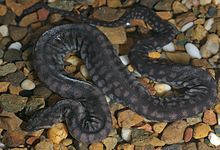Acrochordus arafurae
| Acrochordus arafurae | |
|---|---|

| |
| Scientific classification | |
| Kingdom: | Animalia |
| Phylum: | Chordata |
| Class: | Reptilia |
| Order: | Squamata |
| Suborder: | Serpentes |
| Family: | Acrochordidae |
| Genus: | Acrochordus |
| Species: | A. arafurae
|
| Binomial name | |
| Acrochordus arafurae McDowell, 1979
| |
| Synonyms | |
| |
- Common names: Arafura File snake, Elephant Trunk Snake or wrinkle file snake.
Acrochordus arafurae is an aquatic snake species found in northern Australia and New Guinea. No subspecies are currently recognized.[3]
This snake was first described by Samuel Booker McDowell in 1979[4][5]
Description[]
Adults grown to 8.25 ft (2.5 m) in length.[6] They have amazingly loose skin and are known to prey on large fish, such as eel-tailed catfish. Females are usually larger than males and they have been known to give birth to up to 17 young. The skin is used to make drums in New Guinea.
In Aboriginal language and culture[]
The indigenous peoples of northern Australia often hunt these snakes as they are quite common. As the snakes are near immobilized without the support of water the hunters merely throw each newly caught snake on the bank and continue hunting until they have enough.
In the Kunwinjku language of West Arnhem Land, the snakes are known as kedjebe (or bekka in Eastern dialects),[7] while in the Yolŋu language of East Arnhem Land they are called djaykuŋ,[8] among other names.
References[]
- ^ Sanders, K.; Guinea, M. & Cogger, H. (2010). "Acrochordus arafurae". The IUCN Red List of Threatened Species. IUCN. 2010: e.T176764A7299709. doi:10.2305/IUCN.UK.2010-4.RLTS.T176764A7299709.en. Retrieved 10 January 2018.
- ^ McDiarmid RW, Campbell JA, Touré T. 1999. Snake Species of the World: A Taxonomic and Geographic Reference, vol. 1. Herpetologists' League. 511 pp. ISBN 1-893777-00-6 (series). ISBN 1-893777-01-4 (volume).
- ^ "Acrochordus arafurae". Integrated Taxonomic Information System. Retrieved 16 August 2007.
- ^ "Australian Faunal Directory: Acrochordus arafurae". biodiversity.org.au. Retrieved 2021-07-25.
- ^ S. B. McDowell (26 February 1979). "A Catalogue of the Snakes of New Guinea and the Solomons, with Special Reference to Those in the Bernice P. Bishop Museum. Part III. Boinae and Acrochordoidea (Reptilia, Serpentes)". Journal of Herpetology. 13 (1): 1–92. doi:10.2307/1563761. ISSN 0022-1511. JSTOR 1563761. Wikidata Q56037668.
- ^ Burnie D, Wilson DE. 2001. Animal. Dorling Kindersley. 624 pp. ISBN 0-7894-7764-5.
- ^ Garde, Murray. "kedjebe". Bininj Kunwok Dictionary. Bininj Kunwok Regional Language Centre. Retrieved 10 June 2020.
- ^ "djaykuŋ". Yolŋu Matha Dictionary. Charles Darwin University. Retrieved 10 June 2020.
External links[]
- Acrochordus.com
- Species Acrochordus arafurae at The Reptile Database. Accessed 16 August 2007.
- Arafura Filesnakes at Life is Short but Snakes are Long
- IUCN Red List least concern species
- Acrochordidae
- Snakes of Australia
- Reptiles of Western New Guinea
- Reptiles of Papua New Guinea
- Reptiles described in 1979
- Snakes of New Guinea
- Alethinophidia stubs
